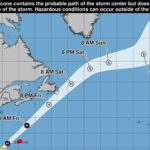
New study published on North Atlantic Heatwave

A new study led by the University of New South Wales (UNSW) and published today in Nature has confirmed what many weather watchers suspected: the record-breaking marine heatwave in the North Atlantic Ocean during summer 2023 wasn’t just unusual — it was off the charts.
According to the research team, the astonishing ocean warming was caused by an unprecedented combination of weakened winds, stronger solar radiation, and ongoing climate change, all creating the perfect storm for what became a full-basin marine heatwave.
“The level of warming we saw in one summer was equivalent to about 20 years of warming,” said lead author Professor Matthew England of UNSW Sydney. “Events like this, while once rare, are becoming the new normal.”
A Summer Like No Other
From the shores of Greenland to the Sahara and across to the Americas, the surface of the North Atlantic heated rapidly during June and July 2023. Instead of the usual wind-driven mixing of surface waters, winds were the weakest on record, leaving the ocean’s surface “mixed layer” unusually thin — in some places just 10 metres deep, compared to the usual 20–40 metres.
With less water to heat and clearer-than-normal skies, the Sun’s energy penetrated directly, causing ocean temperatures to surge.
“It’s like heating a shallow pan — it warms faster than a deep one,” explained Associate Professor Alex Sen Gupta, a co-author of the study.
This intense heating was also helped along by a longer-term trend of climate-induced thinning in the upper ocean, which makes it even harder for winds to mix and cool the surface.
Unexpected Effects of Cleaner Skies
Adding to the mix was a lesser-known side effect of cleaner air. Since 2020, international regulations have reduced sulphur pollution from ships — great for human health, but it also means fewer clouds and more direct sunlight reaching the ocean, especially in busy shipping areas like the North Atlantic.
“It’s a small contributor, but it certainly didn’t help,” Prof. England noted. “Less cloud cover equals more heat in the sea.”
Knock-On Effects Felt Worldwide
This was not a localised event. The warming spanned the entire North Atlantic, causing knock-on effects for European weather, marine ecosystems, and even hurricane activity.
Heatwaves in Germany, France, and Italy hit over 40°C, breaking records and straining infrastructure.
Torrential rain and flooding hit parts of Spain and Eastern Europe.
Coral reefs in the Caribbean experienced widespread bleaching.
Hurricane Idalia, fuelled by warmer ocean water, made landfall in Florida, causing major damage and loss of life.
“This wasn’t just a warm patch off one coast,” said co-author Professor Stefan Rahmstorf of the Potsdam Institute for Climate Impact Research. “This was the whole North Atlantic — with real consequences for people, wildlife, and weather systems.”
What It Means for Ireland and Beyond
While Ireland itself may not have experienced the most extreme temperatures, our Atlantic-facing climate is highly influenced by North Atlantic ocean conditions. Warmer seas can mean more intense storms, heavier rainfall, and longer heatwaves, even here.
This event also affects fisheries, marine biodiversity, and coastal communities across Ireland — all closely tied to ocean temperatures.
Looking Ahead: More to Come?
The study’s authors warn that these marine heatwaves are becoming longer, more intense, and more frequent — and we’re just seeing the beginning.
“The only way to curb this trend is to stop burning fossil fuels,” Prof. England stressed. “We need to reach net zero emissions urgently. Otherwise, these kinds of ocean heat events will keep getting worse — with increasingly severe impacts for everyone.”








